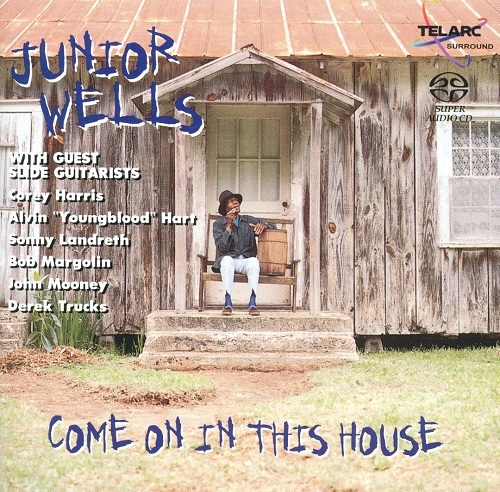Junior Wells - Come On In This House (1996)

Artist: Junior Wells
Title: Come On In This House
Year Of Release: 1996
Label: Telarc
Genre: Blues, Delta Blues, Chicago Blues
Quality: Mp3 320 / Flac (image, .cue, log)
Total Time: 69:20
Total Size: 214/423 Mb (covers)
WebSite: Album Preview
Tracklist:Title: Come On In This House
Year Of Release: 1996
Label: Telarc
Genre: Blues, Delta Blues, Chicago Blues
Quality: Mp3 320 / Flac (image, .cue, log)
Total Time: 69:20
Total Size: 214/423 Mb (covers)
WebSite: Album Preview
1. What My Momma Told Me / That's All Right
2. Why Are People Like That?
3. Trust My Baby
4. Million Years Blues
5. Give Me One Reason
6. Ships On The Ocean
7. She Wants To Sell My Monkey
8. So Glad You're Mine
9. Mystery Train
10. I'm Gonna Move To Kansas City
11. King Fish Blues
12. You Better Watch Yourself
13. Come On In This House
14. The Goat
Junior Wells' penchant for clowning around sometimes conflicts with his craftsmanship, but he's all business on Come on in This House, his most unadulterated blues record since his highly acclaimed Hoodoo Man Blues of more than 30 years vintage. This is what has come to be known as an "unplugged" session -- that is, predominately, although not exclusively, acoustic instrumentation. Producer John Snyder's concept was threefold: to team Wells with some of the era's top younger traditional blues guitarists -- Corey Harris, Alvin Youngblood Hart, Sonny Landreth, Bob Margolin, and John Mooney; to have those musicians, in various combinations, accompany Wells on a variety of slide guitars; and to concentrate on vintage Chicago and Delta blues from the repertoires of Rice Miller, Little Walter, Tampa Red, Arthur Crudup, and Wells himself. The result is a virtual slide-guitar mini-fest and a demonstration of the timeless appeal of classic blues done well. Wells' vocals are deep and manly; his harp playing is high-pitched, like a child's pleading. A surprising highlight is the only contemporary tune on the disc, Tracy Chapman's "Give Me One Reason." New Orleans drummer Herman Ernest III, who appears on 11 of the 14 cuts, does a masterful job laying down understated rhythmic grooves.




![Norbert Schneider - Guitar Speaks (2025) [Hi-Res] Norbert Schneider - Guitar Speaks (2025) [Hi-Res]](https://www.dibpic.com/uploads/posts/2025-12/1765494310_j09zk3wvbwioc_600.jpg)

![Stefan Lovin - Heaven Shines Like Silver (2025) [Hi-Res] Stefan Lovin - Heaven Shines Like Silver (2025) [Hi-Res]](https://img.israbox.com/img/2025-12/12/iof4nx75kf3sa1i0vq1k07kqg.jpg)

![Ben Aylon, Roei Hermon - SMALL ROOM IN DAKAR (2025) [Hi-Res] Ben Aylon, Roei Hermon - SMALL ROOM IN DAKAR (2025) [Hi-Res]](https://www.dibpic.com/uploads/posts/2025-12/1765640683_pl8lfacmwajwc_600.jpg)